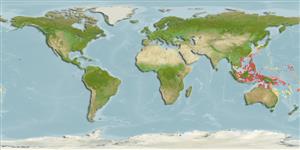>
Gobiiformes (Gobies) >
Gobiidae (Gobies) > Gobiinae
Etymology: Cristatogobius: Latin, cristatus = crested + latin, gobius = gudgeon (Ref. 45335).
More on author: Herre.
Environment: milieu / climate zone / depth range / distribution range
Ökologie
seewasser; brackwasser demersal; tiefenbereich 0 - 12 m (Ref. 37940). Subtropical
Western Pacific: Japan, Philippines, Thailand and Indonesia.
Size / Gewicht / Alter
Maturity: Lm ? range ? - ? cm
Max length : 5.1 cm SL Männchen/unbestimmt; (Ref. 37940)
Rückenflossenstacheln (insgesamt): 7; Rückenflossenweichstrahlen (insgesamt): 9-10; Afterflossenstacheln 1; Afterflossenweichstrahlen: 8 - 9; Wirbelzahl: 26. Black spots on head, body, and pectoral fin base. Larger round to elongate iridescent pale blue or green spots scattered on head and upper anterior part of body, those on upper anterior part of body surrounded both above and below with elongate and inwardly curved or roundish dark brown spots. Several brown transverse bands from dorsal to ventral sides of body. Second dorsal fin mottled with red, yellow, and grey with black spots usually present. Anal fin separated into proximal red and distal black areas with a yellow line on red area close to black area. Caudal fin somewhat lanceolate (Ref. 37940).
Found in brackish waters (Ref. 43239). Occurs in river mouths and bays, on muddy bottoms (Ref. 37940). Found in burrows dug by Alpheus shrimp and other invertebrates (Ref. 37940).
Life cycle and mating behavior
Geschlechtsreife | Fortpflanzung | Ablaichen | Eier | Fecundity | Larven
Akihito and K. Meguro, 2000. Review of the gobiid genus Cristatogobius found in Japan with description of a new species. Ichthyol. Res. 47(3):249-261. (Ref. 37940)
IUCN Rote Liste Status (Ref. 130435)
Bedrohung für Menschen
Harmless
Nutzung durch Menschen
Mehr Information
NamenSynonymeMetabolismusRäuberÖkotoxikologieFortpflanzungGeschlechtsreifeAblaichenSpawning aggregationFecundityEierEientwicklung
Alter/GrößeWachstumLänge-GewichtLänge-LängeLängenhäufigkeitenMorphometrieMorphologieLarvenLarven Pop.Dyn.RekrutierungDichteBRUVS
ReferenzenAquakulturAquakultur ProfilZuchtlinienGenetikElectrophoresesVererbbarkeitKrankheitenVerarbeitungNutrientsMass conversion
PartnerBilderStamps, Coins Misc.LauteCiguateraGeschwindigkeitSchwimmstilKiemenoberflächeOtolithsGehirngrößeSehfähigkeit
Tools
Zusatzinformationen
Download XML
Internet Quellen
Estimates based on models
Preferred temperature (Ref.
123201): 26.1 - 29.3, mean 28.8 °C (based on 1344 cells).
Phylogenetic diversity index (Ref.
82804): PD
50 = 0.5312 [Uniqueness, from 0.5 = low to 2.0 = high].
Bayesian length-weight: a=0.00708 (0.00333 - 0.01504), b=3.09 (2.92 - 3.26), in cm total length, based on LWR estimates for this (Sub)family-body shape (Ref.
93245).
Trophic level (Ref.
69278): 3.2 ±0.3 se; based on size and trophs of closest relatives
Widerstandsfähigkeit (Ref.
120179): hoch, Verdopplung der Population dauert weniger als 15 Monate. (Preliminary K or Fecundity.).
Fishing Vulnerability (Ref.
59153): Low vulnerability (10 of 100).
